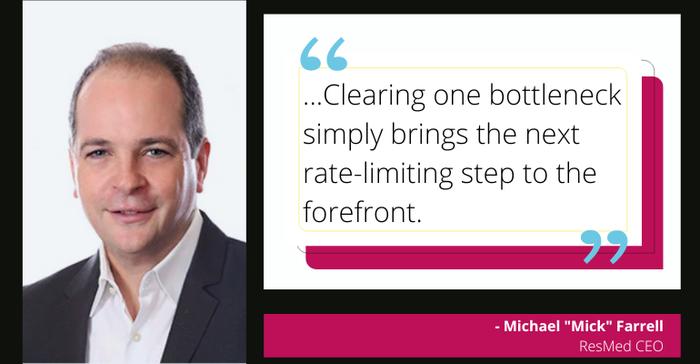Philips' massive recall on ventilators and CPAP machines has been an enormous boon for ResMed, but it hasn't exactly been a cakewalk for the smaller competitor.
August 15, 2022

In June 2021, we wondered if Philips' massive recall on ventilators and CPAP machines would benefit ResMed, a small-but-mighty competitor in the sleep apnea device space. A year into the ongoing recall, the answer is a resounding yes, Philips' loss has certainly been ResMed's gain.
ResMed reported fiscal year 2022 revenues of about $3.58 billion, representing 12% growth over 2021 revenues. The company's fiscal year ended June 30. Philips expects recovery in its flow generator sales to be gradual and take until 2025 to approach pre-recall levels. By that time, ResMed could have a much larger slice of the pie in terms of market share, but just how big that slice will be depends on how well ResMed is able to ramp up manufacturing capacity to meet the almost unlimited demand for its CPAP machines.
George Congdon, an analyst at Third Bridge, made a fairly lofty prediction after interviewing executives in the sector.
"If ResMed can increase capacity, the opportunity is quite significant," Congdon said. "According to our industry expert interviews, a 10% market share shift is ambitious, but not impossible for a strategically savvy and efficiently run corporation such as ResMed."
Congdon added that the semiconductor shortage is a "huge issue" for ResMed, and it is being exacerbated by existing supply chain challenges.
ResMed clears one bottleneck, other bottlenecks remain

"Our ongoing growth reflects our global team's relentless focus to solve very complex supply chain problems and find alternate design and engineering solutions to address the incredible industry challenges that we have faced over the past year and beyond," ResMed CEO Mick Farrell told investors during the company's fourth-quarter earnings call.
There are emerging Indications that semiconductor availability is improving, Farrell said, according to transcripts of the earnings call available on The Motley Fool. He said supplier partners still need to prioritize medtech component needs over those of other industries as demand in the market remains very strong.
"We've been able to mitigate some of the electronic component bottlenecks with the launch of our redesigned card-to-cloud AirSense 10 devices introduced to the market midway through our fourth quarter, Farrell said. "As you can imagine, clearing one bottleneck simply brings the next rate-limiting step to the forefront. Our team is actively working to clear as many bottlenecks as they can as quickly as possible. On the positive news side, the redesign, reengineering, and launch of the card-to-cloud device greatly improved our ability to meet the incredible demand that we see in the marketplace."
ResMed managed to allocate more products to customers during June than it has in recent months and in recent quarters, Farrell said.
"We're not out of the woods yet, but the compass is pointing to true north and we are on top of it," he said.
Ongoing sea-freight and air-freight challenges due to reduced availability and elevated prices are impacting how efficiently ResMed is able to get components into its factories and then to get the finished goods out of those factories to warehouses and ultimately to customers, Farrell said.
ResMed is attacking its supply chain issues from five concurrent supply work streams, the CEO explained.
First, the company is locking in the flow of existing parts from existing suppliers. Second, ResMed is establishing flow of existing parts from new suppliers. Third, it is validating and verifying new parts from existing suppliers. Fourth, ResMed is validating and verifying new parts from new suppliers.
"And then, finally, five, we're reengineering designs to mitigate the major supply bottlenecks," Farrell said. "...We're making good progress with these five lines of work, and we've been able to offset some of the impacts of the component shortages to best support patients, providers, physicians, and beyond."
About the Author(s)
You May Also Like




